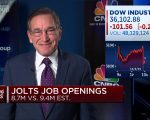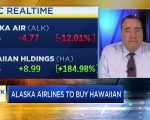People pump gas into their vehicles at a Shell petrol station on October 2, 2023 in Alhambra, California.
Frederic J. Brown | Afp | Getty Images
The U.S. economy has added more than 2.3 million jobs this year, the unemployment rate is still below 4% and there are nearly 10 million open positions out there for anyone still looking for work.
So if a healthy jobs picture is the the cornerstone of a healthy economy, then why do so many people still think things are terrible?
It’s because the rent — along with the food, the gas and the appliances — is still too damn high. In a word: Inflation, which while heading lower in terms of its annual pace, is still far more than most people can stand and is making everything else look, if not terrible, at least less wonderful.
“You see all these high-level headline numbers, and those numbers don’t jibe with your economic reality,” said Elizabeth Crofoot, senior economist at labor analytics firm Lightcast. “I don’t know if there’s a right or wrong, it’s just people’s reality, and aggregate economic statistics sometimes don’t reflect what people are living day to day.”
The latest batch of seemingly great economic news came Friday, when the Labor Department said nonfarm payrolls rose by 336,000 in September. And that wasn’t all: Revisions to July and August showed an additional 119,000 jobs added, and the unemployment rate held steady at 3.8%.That all came on top of what has been another stellar year for job creation.
Yet President Joe Biden’s economic approval rating is just 42%, according to a Reuters/Ipsos poll. Consumer and business sentiment has shown signs of improving — the latest University of Michigan consumer survey shows confidence has returned to around where it was in late-2021 — but is still well below where it was pre-pandemic.
That is likely because prices are still at painful levels.
As an economist, Crofoot says the difficulty high prices are posing can be tough to discern from the macro data. As a consumer, though, she says she can feel it when she takes her two kids out to dinner and sees that not only have prices risen for children’s meals, but things like free drinks for them have been taken away as well.
“It’s the combination of inflation and shrinkflation,” she said. “As a consumer, you feel like you’re being nickeled and dimed at every turn.”
About 10% of consumer items were downsized from 2015-2021, while 4% were upsized, according to the Labor Department. Again, though, the data often don’t seem to match experiences, and the shrinkflation phenomenon — less of a product, with the same or higher prices — seems to be getting worse.
“Consumers just feel like they can’t win, and of course you’re going to feel down on the economy because of that,” Crofoot said.
Higher housing
It hasn’t just been gas and groceries that are making it feel like the cost of living is out of control.
Home prices soared in Covid’s aftermath, pushing people out of urban centers and into outlying regions. The median home sales price has surged 27% since the end of 2019, making owning a home particularly difficult for younger buyers such as millennials.
The median age of a homebuyer in the U.S. is 36, the oldest-ever in data going back to 1981, according to the National Association of Realtors. At the same time, the share of income as a percentage of home prices is at its highest ever, according to government data that goes back to 1987.
“Even though millennials are the largest adult generation in the U.S., they had a shrinking share of buyers in the market last year,” NAR deputy chief economist Jessica Lautz wrote in a recent blog post. “This is at odds with what could happen as the largest number of millennials is at an age they traditionally have entered the market or at least had household formation. This year, baby boomers overtook millennials.”
Higher prices have been one problem. Higher interest rates are another, with 30-year mortgages running at an average 7.83% loan rate, according to Bankrate. Financial markets are on edge that the Federal Reserve could take rates even higher if inflation doesn’t cool.
“This has very significant implications for wealth building,” Crofoot added.
Are the jobs numbers really that good?
Beyond the housing costs, there’s some evidence that the jobs numbers may not be all they’re cracked up to be, either.
After all, more than a quarter of the job creation for September came from lower-wage occupations in the leisure and hospitality industry.
Real career advancement opportunities are tougher to get these days, and Census Bureau surveys have shown growing despair among teens and the Gen Z cohort, who worry about their future on an economic level.

“Inflation continues to be a major source of concern for young adults, offsetting [Friday’s] potentially good employment news,” said William Rodgers III, director of the Institute for Economic Equity at the St. Louis Fed. “It, too, may be contributing to their heightened mental health distress.”
So even as the good macro data continues to pour in, high prices likely will continue to serve as an offsetting factor.
While the consumer price index may show inflation running at a 3.7% annual rate now, it’s about 20% higher than it was since early in the pandemic. The CPI numbers for September will be released Wednesday.
“Prices are high relative to what they were before,” Crofoot said. “So you’re spending more than you can save, and so retirement is going to be further off for you than it was for previous generations.”







